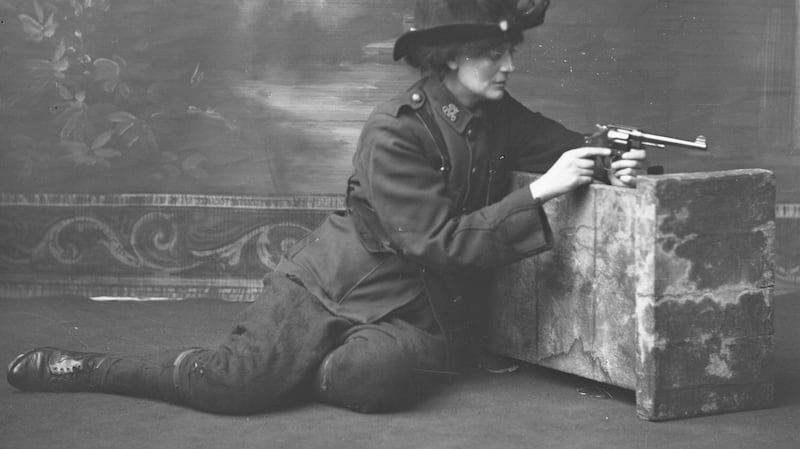Sinn Féin were arguably the biggest victors of the 1918 British general election. Their triumph included the election of Constance Markievicz, the first elected female MP.
In line with Sinn Féin policy, elected members refused their seats in the House of Commons but instead formed the first Dáil Éireann in 1919.
On her release from prison, Markievicz returned to Ireland and to her first sitting at the Dáil. She was nominated minister for labour, making her the first female cabinet minister in either Ireland or Britain.
She proved herself effective in this role, possessing a unique way of solving employment disputes. During a particularly difficult negotiation between her and a certain employer and with no sign of an outcome. Markievicz strode through the room pulled out her gun, pointed it at the terrified employer and said, “ten minutes to settle or I shoot”. You will be glad to know that the employer settled within seven minutes.
Markievicz joined Fianna Fáil upon its establishment in 1926. She was elected as a Fianna Fáil candidate for Dublin South in the 1927 election. Markievicz died five weeks later, at the age of 59.
As leader of the upcoming political party, gender equality did not appear to be a central concern for Éamon de Valera. After all, he refused to accept female insurgents in the outpost that he commanded during the Easter Rising. Years later, he apparently regretted this decision, according to Hanna Sheehy Skeffington because the men had to cook their own food.
Gender balance
Arguably de Valera included Markievicz as a Fianna Fáil candidate not out of concern for gender balance or for her feminist politics but because he was dependent on public support.
Markievicz, known as the “people’s countess” was an intrinsic element for Fianna Fáil to gain followers. When she died in a public ward of Sir Patrick Dun’s hospital, her legacy quickly began to unfold.
Due to ongoing hostilities with the Free State government, Markievicz was denied a State funeral. Her body lay in the Pillar Room of the Rotunda hospital and she received a public funeral. However, she proved to have earned the respect of the people of Ireland who lined the streets in their thousands to honour her funeral cortege.
Due to ongoing hostilities with the Free State government, Markievicz was denied a State funeral
The next woman to succeed Markievicz in a cabinet role in Dáil Éireann was Máire Geoghegan-Quinn who was not appointed until 1979, as minister for the Gaeltacht, 60 years after Markievicz was appointed a minister.
De Valera wiped out the record of successes made by Markievicz in a very real way. When he oversaw the redrafting of the Constitution in 1937, women were positioned as inferior. Articles were inserted into that document declaring women’s ultimate place as being in the domestic sphere.
Article 41.2.2, which still remains, includes a section declaring that “the State recognises that by her life within the home, woman gives to the State a support without which the common good cannot be achieved”. This section is only now being given consideration for replacement. Replacing this article with a gender-neutral statement would ensure that the Constitution would be more closely aligned with the values Markievicz fought hard to instil.
‘Permanent inferiority’
The release of the draft version of the Constitution did not go unnoticed by feminists in 1937. Hanna Sheehy-Skeffington was inspired to write to the Irish Independent asserting that the Constitution is "a fascist model, in which women would be relegated to permanent inferiority". The implications of the 1937 Constitution were far-reaching, coupled with the lack of a strong female replacement for Markievicz in Irish politics.
It is essential that women are put before all children, particularly girls, so there is some sort of role model for them in political life

Irish politics is still male-dominated. In efforts to improve gender balance it is Markievicz who is the icon for change. A full-length painting of the countess hangs on the stairs to Seanad Éireann. The painting was removed during renovations to the building and during a Seanad debate, Senator Mary Henry noted the importance of ensuring the painting was returned to its rightful position.
Her speech highlights the importance not only of Markievicz’s work in shaping a modern Ireland but as a symbol to inspire future generations. Henry insisted that, “it is of great importance to show women were involved in our past. It is essential that women are put before all children, particularly girls, so there is some sort of role model for them in political life.”
Women’s participation in Irish politics remains below the European average, at only 22 per cent of TDs. The legacy of Constance Markievicz is a central inspiration for change. I was honoured to be in the House of Commons in July 2018 when Oireachtas members and representatives from Votail 100 presented a portrait of Markievicz to the Speaker of the House, John Bercow. Markievicz now takes her rightful position among the male politicians there.
Sonja Tiernan is an associate professor of modern history and head of the department of history and politics at Liverpool Hope University.This article is based on her plenary address to the Parnell Summer School








